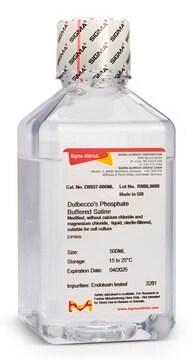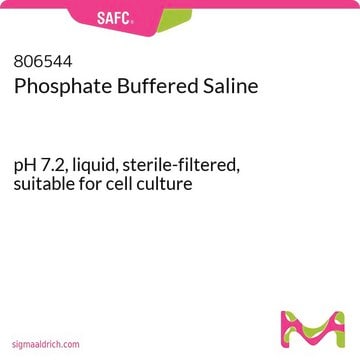D8662
Dulbecco′s Phosphate Buffered Saline
Liquid, with MgCl₂ and CaCl₂, sterile-filtered, suitable for cell culture
Synonym(s):
DPBS
Sign Into View Organizational & Contract Pricing
All Photos(1)
About This Item
Recommended Products
Product Name
Dulbecco′s Phosphate Buffered Saline, With MgCl2 and CaCl2, liquid, sterile-filtered, suitable for cell culture
Quality Level
sterility
sterile-filtered
form
liquid
technique(s)
cell culture | mammalian: suitable
impurities
endotoxin, tested
components
sodium pyruvate: no
glucose: no (Dextro)
shipped in
ambient
storage temp.
2-8°C
Looking for similar products? Visit Product Comparison Guide
General description
Dulbecco′s Phosphate Buffered Saline (D-PBS) is a balanced salt solution developed for use in tissue culture.
Application
D-PBS is a general use isotonic saline solution used to wash cells during preparation and serial transfer.
Dulbecco′s Phosphate Buffered Saline has been used:
- as a component of the reaction mixture for the fluoro-labeling reaction of pro-nerve growth factor (proNGF)-YBBR
- to wash and equilibrate the cells post transepithelial electrical resistance (TEER) measurement of Caco-2BBe cells
- to wash cells for protein isolation
Dulbecco′s Phosphate Buffered Saline has been used:
- as a component of the reaction mixture for the fluoro-labeling reaction of pro-nerve growth factor (proNGF)-YBBR
- to wash and equilibrate the cells post transepithelial electrical resistance (TEER) measurement of Caco-2BBe cells
- to wash cells for protein isolation
Biochem/physiol Actions
Dulbecco′s Phosphate Buffered Saline (D-PBS) exhibits four chief functions:
- provides cells with water and certain bulk inorganic ions essential for normal cell metabolism
- serves as an irrigating, transporting, and diluting fluid while maintaining intra- and extracellular osmotic balance
- when combined with a carbohydrate, such as glucose, provides the principal energy source for cell metabolism
- provides a buffering system to maintain the medium within the physiological pH range
related product
Product No.
Description
Pricing
Storage Class Code
12 - Non Combustible Liquids
WGK
nwg
Flash Point(F)
Not applicable
Flash Point(C)
Not applicable
Choose from one of the most recent versions:
Already Own This Product?
Find documentation for the products that you have recently purchased in the Document Library.
Customers Also Viewed
E Valas Teuma et al.
Journal of cataract and refractive surgery, 45(8), 1177-1182 (2019-07-06)
To compare the capsulotomy rim strength with capsular marks (CMs) to the rim strength without CMs in porcine eyes, and to demonstrate the practicality of CMs for intraoperative toric intraocular lens (IOL) alignment. LENSAR facility, Orlando, Florida, USA. Laboratory study.
L Parmegiani et al.
Journal of assisted reproduction and genetics, 35(10), 1887-1895 (2018-08-04)
To study the efficacy and efficiency of a "universal warming protocol" for vitrified human embryos, based on subsequent steps with 1 and 0.5 M concentration of extracellular cryoprotectant (ECCP). Two studies on patients undergoing fertility treatments via ICSI: a prospective randomized
Michele Russo et al.
European journal of heart failure, 21(4), 519-528 (2019-03-08)
Butyric acid (BUT), a short chain fatty acid produced daily by the gut microbiota, has proven beneficial in models of cardiovascular diseases. With advancements in cancer survival, an increasing number of patients are at risk of anticancer drug cardiotoxicity. Here
Ivan Kopljar et al.
British journal of pharmacology, 174(21), 3766-3779 (2017-01-18)
In the pharmaceutical industry risk assessments of chronic cardiac safety liabilities are mostly performed during late stages of preclinical drug development using in vivo animal models. Here, we explored the potential of human induced pluripotent stem cell-derived cardiomyocytes (hiPS-CMs) to
Proximal tubule apical endocytosis is modulated by fluid shear stress via an mTOR-dependent pathway.
Kimberly R Long et al.
Molecular biology of the cell, 28(19), 2508-2517 (2017-07-20)
Cells lining the proximal tubule (PT) have unique membrane specializations that are required to maintain the high-capacity ion transport and endocytic functions of this nephron segment. PT cells in vivo acutely regulate ion transport in response to changes in glomerular
Our team of scientists has experience in all areas of research including Life Science, Material Science, Chemical Synthesis, Chromatography, Analytical and many others.
Contact Technical Service









